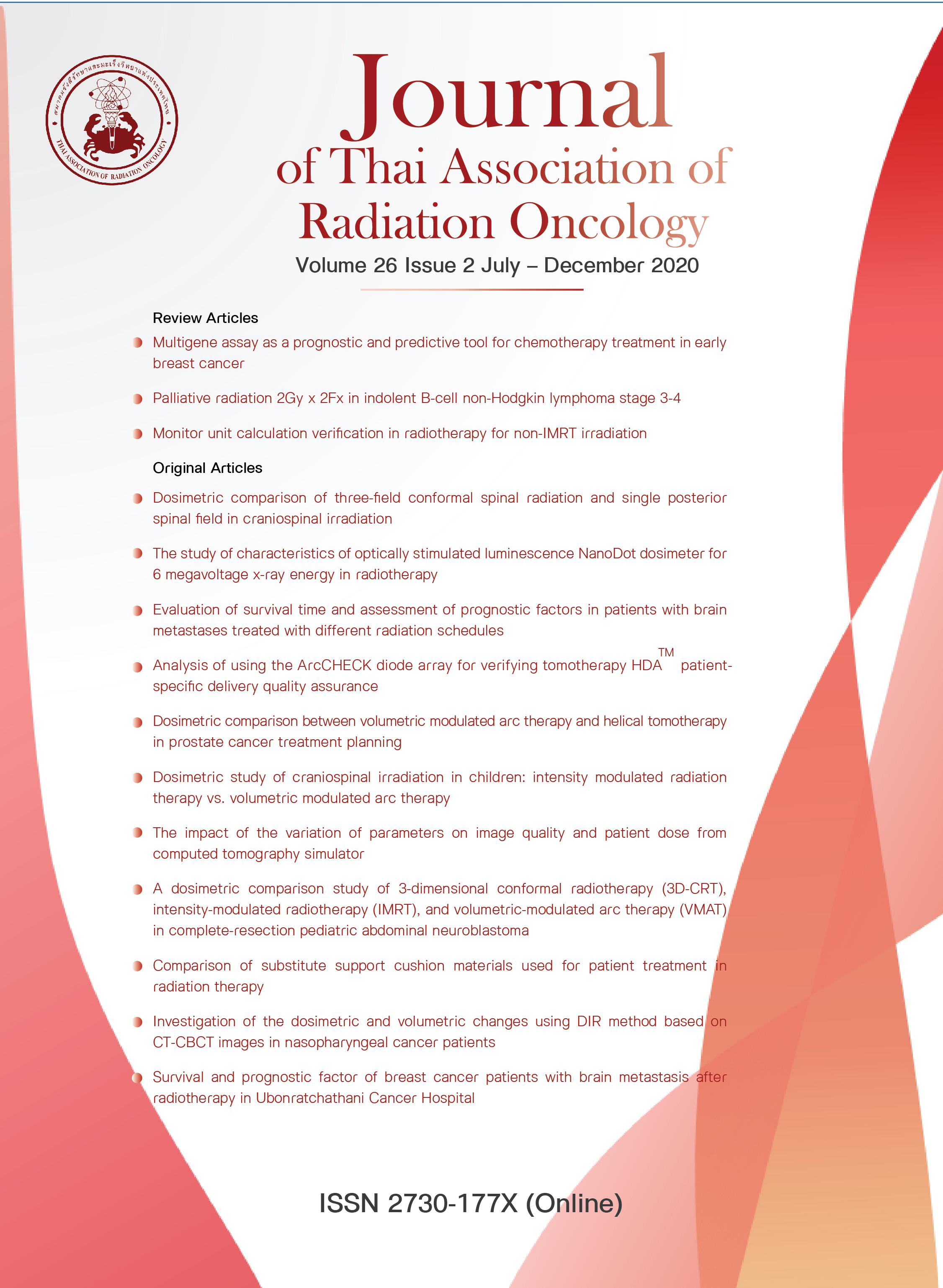Dosimetric Comparison between Volumetric Modulated Arc Therapy and Helical Tomotherapy in Prostate Cancer Treatment Planning
Keywords:
Dosimetric Comparison, Volumetric Modulated Arc Therapy, Helical Tomotherapy, Prostate cancerAbstract
Background: Prostate cancer is common in Thai males. The two major radiation therapy advance techniques, volumetric modulated arc therapy (VMAT) and helical tomotherapy (HT), provide high-precision radiation dose to planning target volume (PTV) while sparing organs at risk (OARs) in prostate radiotherapy.
Objectives: To compare the dosimetric parameters and treatment efficiency between VMAT and HT treatment plan for prostate cancer.
Materials and Methods: This is a retrospective study of sixteen prostate cancer patients who were treated with Simultaneous integrated boost (SIB) technique using HT. The PTV includes the prostate (PTV-P) and pelvic lymph nodes (PTV-LN). The prescription doses for PTV-P and PTV-LN were 70 Gy and 50.4 Gy in 28 fractions, respectively. These patient images data were used to generated Single-arc (SA) and Double-arc (DA) VMAT plan by Monaco planning system. The same computed tomography images and structure contours data sets were used. Target volumes were constrained according to the criteria of the International Commission on Radiation Units and Measurements (ICRU) report no.83 and the OAR doses were evaluated by following the criteria of Radiation Therapy Oncology Group (RTOG) 0415 report and ICRU 83. The plan quality assessment indexes were the conformity number (CN) and the homogeneity index (HI). The OAR (bladder, rectum, femoral heads, penile bulb and bowels) doses were evaluated by following criteria of RTOG 0415 and ICRU 83 (D50, D10, Mean dose and D2). The beam-on time was also compared for the treatment efficiency assessment.
Results: The SA and DA VMAT achieved clinically acceptable dosimetric goals. There was no statistically significant difference (p>0.05) between these plans and the previous HT plan. CN showed no statistically significant difference between these plans. HT provided significantly better HI than DA VMAT and SA VMAT(p<0.05). For the OAR dose, HT had significantly lower bladder, rectum and femoral heads dose but higher penile bulb dose. DA VMAT had significantly lower bladder and bowels dose but higher penile bulb dose than SA VMAT. SA VMAT and DA VMAT had shorter beam-on time than HT.
Conclusion: All three plans achieved clinically acceptable dosimetric quality goals. HT provided better homogeneous dose distribution and lower dose to OARs. HT had the longest beam-on time.
References
สถาบันมะเร็งแห่งชาติ. ทะเบียนมะเร็งระดับโรงพยาบาล พ.ศ. 2558. กรุงเทพมหานคร:บริษัท พรทรัพย์การพิมพ์ จำกัด; 2558.
สถาบันมะเร็งแห่งชาติ. ทะเบียนมะเร็งระดับโรงพยาบาล พ.ศ. 2559. กรุงเทพมหานคร:บริษัท พรทรัพย์การพิมพ์ จำกัด; 2559.
สถาบันมะเร็งแห่งชาติ. ทะเบียนมะเร็งระดับโรงพยาบาล พ.ศ. 2560. กรุงเทพมหานคร:บริษัท พรทรัพย์การพิมพ์ จำกัด; 2560.
Min R, Wensha Y, Fan C, Ke S, Jinsong Y, Vivek M, et al. Comparison of Elekta VMAT with helical tomotherapy and fixed field IMRT: Plan quality, delivery efficiency and accuracy. Med Phys. 2010;37:1350-59.
Rana1 S, Cheng C.Y. Feasibility of the partial-single arc technique in RapidArc planning for prostate cancer treatment. Chin J Cancer. 2013;32:546–52.
Sze HC, Lee MC, Hung WM, Yau TK, Lee AW. RapidArc Radiotherapy Planning for Prostate Cancer: Single-Arc and Double-Arc Techniques vs. Intensity-Modulated Radiotherapy. Med Dosim. 2012;37:87-91.
Langen K.M, Papanikolaou N, Balog J, Crilly R, Followill D, Goddu S.M, et al. QA for helical tomotherapy: Report of the AAPM Task Group 148. Med Phys. 2010;37:4817-53.
Kinhikar RA, Pawar AB, Mahantshetty U, Murthy V, Dheshpande DD, Shrivastava SK. Rapid Arc, Helical Tomotherapy, Sliding Window Intensity Modulated Radiotherapy and Three Dimensional Conformal Radiation for Localized Prostate Cancer: A Dosimetric Comparison. J Cancer Res Ther. 2014;10:575-82.
Scobioala S, Kittel C, Wissmann N, Haverkamp U, Channaoui M, Habibeh O, et al. A Treatment Planning Study Comparing Tomotherapy, Volumetric Modulated Arc Therapy, Sliding Window and Proton Therapy for Low-Risk Prostate Carcinoma. Radiat Oncol. 2016;11:128.
Lin J.C, Tsai J.T, Chen L.J, Li M.H, Liu W.H. Compared planning dosimetry of TOMO, VMAT and IMRT in rectal cancer with different simulated positions. Oncotarget. 2017;8:42020–29.
International Commission on Radiation Units and Measurements Report 83. Prescribing, recording, and reporting photon-beam intensity-modulated radiation therapy (IMRT). J ICRU. 2010;10.
Chawapun N. IsoBED: Biologically Equivalent Fractionation Schedules in Radiotherapy Using IMRT with a Simultaneous Integrated Boost (SIB) Technique. J Thai Soc Ther Radiat Oncol 2015;21:11-7.
NRG Oncology RTOG 0415. A Phase III Randomized Study of Hypofractionated 3D-CRT/IMRT versus Conventionally Fractionated 3D-CRT/IMRT in Patients with Favorable-Risk Prostate Cancer. [internet]. [cited 2019 Feb 8]. Available from: https://www.rtog.org/ClinicalTrials/ProtocolTable/StudyDetails.aspx?action=openFile&FileID=4624.
Van't Riet A, Mak AC, Moerland MA, Elders LH, van der Zee W. A conformation number to quantify the degree of conformality in brachytherapy and external beam irradiation: application to the prostate. Int J Radiat Oncol Biol Phys. 1997;37:731–6.
Tsai CL, Wu JK, Chao HL, Tsai YC, Cheng JC. Treatment and dosimetric advantages between VMAT, IMRT, and helical tomotherapy in prostate cancer. Med Dosim. 2011;36:264-71.
Pasquier D, Cavillon F, Lacornerie T, Touzeau C, Tresch E, Lartigau E. A dosimetric comparison of tomotherapy and volumetric modulated arc therapy in the treatment of high-risk prostate cancer with pelvic nodal radiation therapy. Int J Radiat Oncol Biol Phys. 2013;85:549-54.
Davidson MT, Blake SJ, Batchelar DL, Cheung P, Mah K. Assessing the role of volumetric modulated arc therapy (VMAT) relative to IMRT and helical tomotherapy in the management of localized, locally advanced, and post-operative prostate cancer. Int J Radiat Oncol Biol Phys. 2011;80:1550-8.
Yampolsky H, Martyn B, Squire D, Hartwick T, Botnick M, Botnick L, et al. Comparison of Plan Quality Provided by Volumetric Modulated Arc Therapy and Helical Tomotherapy. J Radiat Oncol Biol Phys. 2009;75:728
Guckenberger M, Richter A, Krieger T, Wilbert J, Baier K, Flentje M. Is a single arc sufficient in volumetric-modulated arc therapy (VMAT) for complex-shaped target volumes? Radiother Oncol. 2009;93:259-65.
Downloads
Published
How to Cite
Issue
Section
License
บทความที่ได้รับการตีพิมพ์เป็นลิขสิทธิ์ของวารสารมะเร็งวิวัฒน์ ข้อความที่ปรากฏในบทความแต่ละเรื่องในวารสารวิชาการเล่มนี้เป็นความคิดเห็นส่วนตัวของผู้เขียนแต่ละท่านไม่เกี่ยวข้องกับ และบุคคลากรท่านอื่น ๆ ใน สมาคมฯ แต่อย่างใด ความรับผิดชอบองค์ประกอบทั้งหมดของบทความแต่ละเรื่องเป็นของผู้เขียนแต่ละท่าน หากมีความผิดพลาดใดๆ ผู้เขียนแต่ละท่านจะรับผิดชอบบทความของตนเองแต่ผู้เดียว




